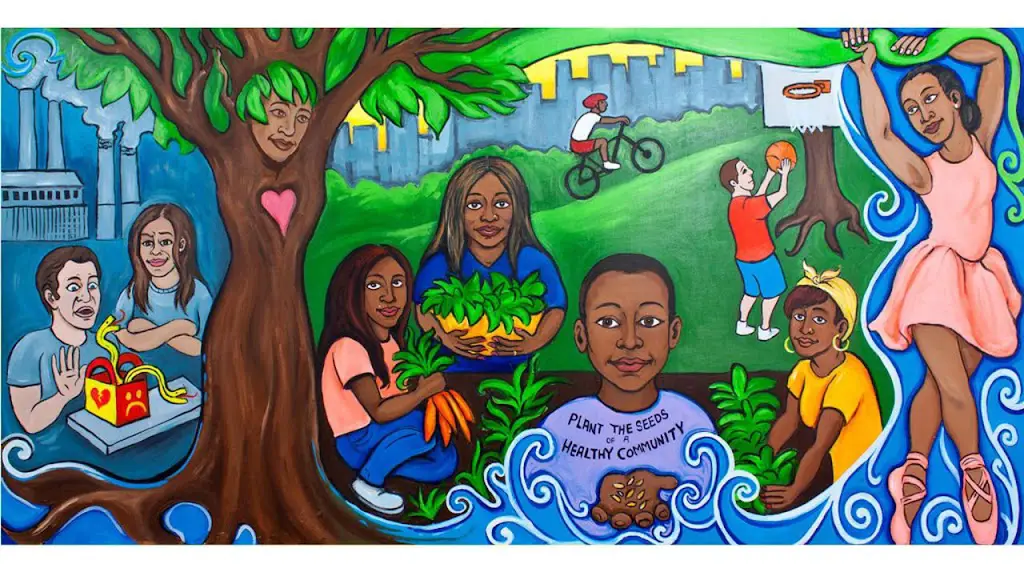A healthy community is one in which individuals have access to resources and opportunities that promote physical, mental, and social well-being. It is characterized by an environment that supports healthy lifestyles and behaviors, and where people feel connected to and supported by their neighbors and community members.
Some key components of a healthy community include:
Access to healthy food options: A healthy community has grocery stores, farmers markets, and other food sources that offer a variety of fresh, nutritious foods.
Safe and accessible outdoor spaces: Parks, trails, and other outdoor areas that are well-maintained, safe, and accessible to all can promote physical activity and a sense of community
Quality healthcare: A healthy community provides access to quality healthcare services, including preventive care, mental health services, and treatment for chronic conditions.
Affordable housing: Housing that is affordable, safe, and free from environmental hazards can improve overall health outcomes.
Strong social connections: A healthy community encourages social connections and support networks, which can improve mental health and reduce social isolation.
Safe and supportive schools: Schools that promote healthy behaviors, physical activity, and social-emotional learning can help young people develop lifelong healthy habits.
Opportunities for civic engagement: A healthy community offers opportunities for residents to engage in decision-making processes and community building, which can foster a sense of ownership and investment in the community.
Overall, a healthy community is one in which individuals have access to resources and opportunities that promote physical, mental, and social well-being, and where people feel connected to and supported by their neighbors and community members.
4 ways to get healthy community
Here are four ways to help create a healthy community:
Promote healthy behaviors: Encourage healthy behaviors such as regular physical activity, healthy eating, and avoiding tobacco and substance use. This can be done through community events, educational programs, and public health campaigns.
Develop partnerships: Build partnerships with local businesses, schools, healthcare providers, and community organizations to work together on initiatives that support health and well-being. For example, a community garden could be established in partnership with a local school or a farmers market could be organized with the help of local businesses.
Address social determinants of health: Identify and address social determinants of health, such as poverty, housing insecurity, and limited access to healthcare, which can have a significant impact on health outcomes. This can be done through advocacy efforts, community organizing, and collaborations with government agencies and nonprofits.
Foster a sense of community: Encourage community engagement and social connections through events, volunteer opportunities, and other activities. This can help foster a sense of community and belonging, which can have a positive impact on mental health and overall well-being.
Promote healthy behaviors
Promoting healthy behaviors is an important aspect of creating a healthy community. Here are some ways to promote healthy behaviors:
Provide access to healthy foods: Encourage the availability of healthy food options by establishing farmers markets, community gardens, and healthy food initiatives. This can increase access to fresh fruits and vegetables and reduce the availability of unhealthy foods.
Promote physical activity: Encourage physical activity by creating safe, accessible, and well-maintained public spaces, such as parks and trails. Organize community events, such as walks, runs, and bike rides, to promote physical activity and community engagement.
Encourage healthy lifestyle choices: Educate the community on healthy lifestyle choices, such as regular exercise, healthy eating, and getting enough sleep. Provide resources, such as classes and workshops, to help community members learn and adopt healthy habits.
Provide access to healthcare: Ensure that community members have access to affordable and high-quality healthcare services, including preventive care and treatment for chronic diseases. This can be done by partnering with local healthcare providers, establishing community clinics, and promoting health insurance enrollment.
Reduce tobacco and substance use: Implement policies and programs to reduce tobacco and substance use, such as smoke-free laws and substance abuse prevention programs. Provide resources to help community members quit smoking and seek treatment for substance abuse.
By promoting healthy behaviors, communities can help prevent chronic diseases, improve overall health outcomes, and create a culture of wellness.
Develop partnerships
Developing partnerships is an effective way to create a healthy community. Here are some ways to develop partnerships:
Collaborate with local businesses: Partner with local businesses to promote healthy behaviors, such as offering healthy food options in restaurants and grocery stores, or sponsoring community events that promote physical activity.
Work with schools and universities: Partner with schools and universities to provide education on health and wellness. For example, schools can provide health education classes and healthy school meals, while universities can provide wellness programs and research on health issues.
Engage healthcare providers: Work with healthcare providers to provide preventive care and treatment for chronic conditions. This can involve establishing community clinics or collaborating with healthcare providers to offer free or low-cost screenings and health fairs.
Partner with community organizations: Partner with community organizations to address social determinants of health, such as poverty, housing insecurity, and lack of access to healthy food. This can involve collaborating on advocacy efforts or establishing community programs that provide resources to those in need.
Collaborate with government agencies: Partner with government agencies to establish policies that promote health and wellness, such as smoke-free laws, bike lanes, and healthy food initiatives. This can involve advocating for policies that promote health and wellness and collaborating with government agencies to implement these policies.
By developing partnerships, communities can leverage the strengths and resources of multiple stakeholders to create a culture of health and wellness.
Address social determinants of health
Addressing social determinants of health is an essential aspect of creating a healthy community. Here are some ways to address social determinants of health:
Promote economic opportunity: Provide opportunities for education and job training to help community members attain stable employment and financial stability. This can help reduce poverty, which is a major social determinant of health.
Improve access to affordable housing: Address housing insecurity by providing affordable housing options and promoting housing policies that prevent displacement and discrimination. Safe and affordable housing is essential for physical and mental well-being.
Increase access to healthy food: Address food insecurity by promoting access to healthy food options. This can involve establishing community gardens, farmers markets, and healthy food initiatives.
Address environmental health hazards: Address environmental health hazards, such as air and water pollution, that can have a negative impact on health outcomes. This can involve advocating for environmental policies and partnering with community organizations to address environmental health hazards.
Improve access to healthcare: Ensure that all community members have access to quality healthcare services, including preventive care and treatment for chronic diseases. This can involve establishing community clinics, partnering with healthcare providers, and advocating for health insurance enrollment.
By addressing social determinants of health, communities can improve health outcomes for all community members, especially those who are most vulnerable.
Foster a sense of community
Fostering a sense of community is an important aspect of creating a healthy community. Here are some ways to foster a sense of community:
Encourage community engagement: Provide opportunities for community members to engage with one another through community events, volunteer opportunities, and other activities. This can help create a sense of belonging and connectedness.
Promote diversity and inclusion: Encourage diversity and inclusion in all aspects of community life. This can involve promoting cultural events and celebrations, providing resources for immigrants and refugees, and promoting equal access to community resources.
Support local businesses: Encourage community members to support local businesses by promoting local shopping and dining options. This can help build a sense of pride in the community and promote economic development.
Encourage neighborhood beautification: Promote neighborhood beautification through community-led efforts, such as community gardens, street cleanups, and public art projects. This can help build a sense of ownership and pride in the community.
Establish community traditions: Establish community traditions and rituals, such as annual festivals, parades, and cultural celebrations. This can help create a sense of shared history and identity.
Create safe public spaces: Ensure that public spaces are safe and well-maintained, including parks, playgrounds, and public gathering spaces. This can promote community gathering and physical activity.
By fostering a sense of community, communities can create a culture of health and wellness that supports the physical, social, and emotional well-being of all community members.





